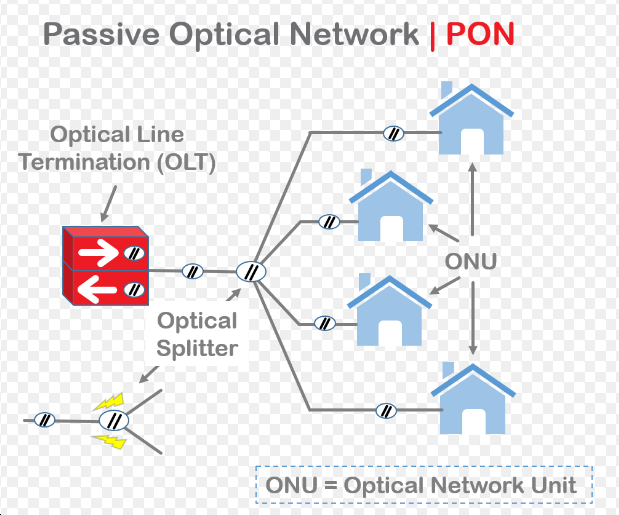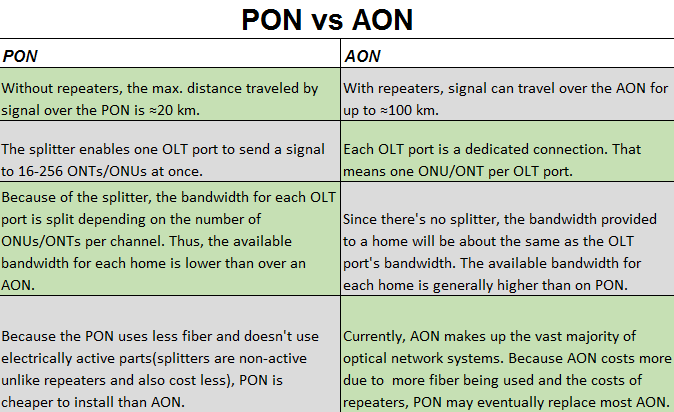Optical network refers to the conversion between optical and electrical signal at the input port and output port, and is always in the form of light in the network transmission and exchange process. Light source is the heart of optical fiber communication, the type and performance of the light source to a large extent determine the type of system, performance and cost.
Now, the representative active optical access network is mainly uses Active Ethernet technology, which adopts single fiber bi-directional and point-to-point directly access to the users that greatly improve the bandwidth and the costs also increased, therefore the active optical access technology is gradually replaced by passive optical access technology (PON), PON balances bandwidth and cost.
What is AON?
AON (Active Optical Network) refers to a network that in the transmission process, signal adopts photoelectric conversion device, active optical assemblies from OLT devices to user distribution units and fiber optic etc. to transmit. Active optical assemblies includes light source (laser), optical receiver, Optical Transceiver module, optical amplifier (fiber amplifier and semiconductor optical amplifier), etc. The active optical network belongs to the point-to-multipoint optical communication system, which is composed of ONU, optical remote terminal OLT and optical fiber transmission line.

Features:
- Large transmission capacity: 155Mb/s or 622Mb/s access rate
- Long transmission distance: more than 70km without repeater
- Mature technology: PDH devices and SDH devices have been widely used
What is Passive Optical Network?
Passive Optical Network (PON) refers to the network is the optical distribution network (ODN) between OLT and ONU and have no any active electronic devices, it includes Passive Optical Network that based on ATM (APON) and Passive Optical Network that based on IP (E/GPON).
The concept of Passive Optical Network (PON) was firstly proposed by British Telecom researchers in 1987, is a access network for application fiber, because it has no any electronics that uses power from OLT to ONU, the devices used include optical fibers, optical splitter, etc., are passive devices that called “passive optical network”.

Features:
The downlink rate of PON is 622Mbps or 155Mbps, and uplink rate is 155Mbps.
Among a verity of broadband access technology, passive optical network becomes a popular technology with its large capacity, long transmission distance, low cost and all-service support. The passive optical networks that have been commercialized are TDM-PON (APON, EPON, GPON) and WDM-PON, and their common features are:
- Excellent performance of update, cost-effective, removed the active devices when access to the network, thus avoiding the electromagnetic interference and lightning effects, reducing the failure rate of lines and external equipment, and decreasing the cost of operating and maintenance.
- Great transparency of business, high bandwidth, can applied to the signal with any format and rate, can be more economical to support analog radio and television services, support triple play (voice, video, data) business;
- High reliability, providing QoS guarantee for different business priority, adapt to the development trend of broadband access market IP and large-scale application.
This kind of network is a point-to-multipoint fiber transmission and access network, which has some outstanding advantages like optical cable source saving, high security, fast network construction, low cost and so on, thus with the wide application of fiber access technology FFTB, FTTC and FTTZ etc. passive optical network comes to be the best ideal access way of various FTTx and has been widely used. Currently the PON standard specifications that have been formed include: APON (ATM-PON), EPON (EthernetoverPON) and GPON.
The difference between active optical network and passive optical network
In the active optical network, ONU devices cascaded in the fiber optic network and the signal received by each ONU is a signal obtained by the upper ONU optical-electrical-optical conversion. While in the passive optical network, ONU devices device connected to the optical fiber network through the optical splitter, and the signal received by ONU is directly sent by OLT.
Active optical network system have to add optical interface board at the branch node to achieve optical direction increases when the network need to add branch. While passive optical network system just need to replace optical splitter, and use more shunting optical splitter to increase the optical direction, so passive optical network system is more convenient to expand than active optical network system, and the investment cost is lower. Meanwhile, passive optical network system has a more reliable protection mechanism for the network security that includes:
- Single node protection: the failure of one node in the network doesn’t affect the work of the other nodes, and have the ability to resist multi-node failure simultaneously.
- Whole network protection: adopts the same double optical plane protection mechanism, provides 1 + 1 channel protection and 1 + 1 circuit protection, automatically switch optical plane to effectively ensure the security of the network.
Comparison of PON and AON:

Source: https://www.cozlink.com/dac-aoc-a272-2470-2471/article-73742.html

